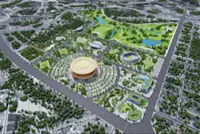A render of the waterfront theatre in the central area of the Can Gio urban area. — Courtesy of Can Gio District People's Committee HCM CITY
HCM CITY (Vietnam News Network/Asia News Network): HCM City plans to turn Can Gio district into an ecological urban area as part of efforts to urbanise it and improve the quality of life for locals.
With a 13-km coastline and extensive mangrove forest intertwined with a dense system of rivers, canals and diverse flora and fauna, Can Gio has huge potential to develop eco-tourism, community-based tourism, and resort tourism, experts say.





